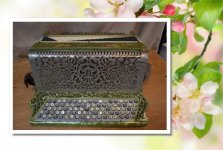You are using an out of date browser. It may not display this or other websites correctly.
You should upgrade or use an alternative browser.
You should upgrade or use an alternative browser.
Anyone know this layout?
- Thread starter saabanders
- Start date
Dingo40
Been here for ages!
Heroic musicians !

Is your question about the button keyboards?
I've seen it referred to as Do2 or D-Griff (unsure on the reasoning of that name). Apparently popular in parts of Belgium. I think a search for Do2 will pop up some results here. In line with what Kimric said, it is a B-griff layout shifted by one row. There are 6 possible layouts for a CBA keyboard arranged by minor thirds in the rows. Those we call B and C-griff are the most popular, but at least a few of the 4 other layouts have been implemented.
Alan Sharkis
Prolific poster
I don’t have one handy at the moment, but the Roland Reference Manual for the FR-4x (and presumably the 8x) which covers piano and CBA models cites 6 right-hand layouts and has diagrams for each of the six. As I recall, the D-griff is one of those layouts in that manual.
The two accordions in the pictures are different.I've seen it referred to as Do2 or D-Griff (unsure on the reasoning of that name). Apparently popular in parts of Belgium. I think a search for Do2 will pop up some results here. In line with what Kimric said, it is a B-griff layout shifted by one row. There are 6 possible layouts for a CBA keyboard arranged by minor thirds in the rows. Those we call B and C-griff are the most popular, but at least a few of the 4 other layouts have been implemented.
The one on the right is Do2.
The one on the left just doesn't make sense to me.
Oh my, I hadn't noticed. Maybe the owner shifted the button caps in rows 1 and 4 for aesthetics?The two accordions in the pictures are different.
The one on the right is Do2.
The one on the left just doesn't make sense to me.
It is the one to the left that is the problem. Never seen it before. Maybe he has moved the buttons, mut I do not think soThe two accordions in the pictures are different.
The one on the right is Do2.
The one on the left just doesn't make sense to me.
With the accordion on the left in one diagonal direction you have three white buttons in a row and in the other diagonal direction you have even four white buttons in a row. On a chromatic accordions you cannot have more than two white buttons in a row in the diagonal direction that you play. So this layout cannot correspond to any chromatic button system.
Neil Thornock
Member
It looks like it could be related to an English concertina layout, though somewhat different. On the three outer rows, you would have the seven white notes in one group, with accidentals to the outside of those white notes. The inner two rows would make octave transitions easier. Maybe the extra white notes at the top end are like a short octave on an organ. That would make sense enough to me, though it's all just a guess. Strange layout!!
As Paul said, the black and white pattern on the left hand accordion doesn't seem to make sense.
On the other hand on a 5 row chromatic keyboard you'd expect rows four and five to match rows one and two. They do match when shifted "up" slightly, which suggests B-griff mechanism. So the black white pattern isn't purely decorative, but still doesn't make sense?
On the other hand on a 5 row chromatic keyboard you'd expect rows four and five to match rows one and two. They do match when shifted "up" slightly, which suggests B-griff mechanism. So the black white pattern isn't purely decorative, but still doesn't make sense?
Ventura
Been here for ages!
well here is another odd duck


Albin Hagstrom Alvdalen 5 Row Accordion - musical instruments - by...
Albin Hagstrom Alvdalen 5 Row Accordion with case for sale in good condition. There is a sticker for Norwegian Cruises 1958 so I assume it's that old. Bellows are not torn, there are some minor...
jerseyshore.craigslist.org
Attachments
That's not an "odd duck" but a standard C-system accordion.well here is another odd duck
Ventura
Been here for ages!
the full trapezoid shape is not that unusual then ?
i had never seen one that wasn't squared up
i had never seen one that wasn't squared up
Ikesaccordions
Active member
They both look like C-system to me, but how would I know?
Similar threads
- Replies
- 0
- Views
- 40
- Replies
- 4
- Views
- 146
- Replies
- 3
- Views
- 192
- Replies
- 8
- Views
- 233
- Replies
- 0
- Views
- 117


